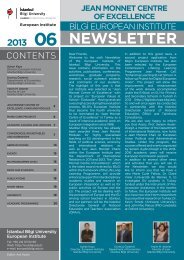WP2 Turkey: Country Report - İstanbul Bilgi Üniversitesi | AB Enstitüsü
WP2 Turkey: Country Report - İstanbul Bilgi Üniversitesi | AB Enstitüsü
WP2 Turkey: Country Report - İstanbul Bilgi Üniversitesi | AB Enstitüsü
You also want an ePaper? Increase the reach of your titles
YUMPU automatically turns print PDFs into web optimized ePapers that Google loves.
Social Impact of Emigration and Rural-Urban Migration in Central and Eastern Europe<br />
VT/2010/001<br />
IDPs in <strong>Turkey</strong> cannot fully enjoy their right to education, partly because of the elements of<br />
the Turkish domestic law impeding full exercise of the right. <strong>Turkey</strong>’s interpretation of nondiscrimination<br />
leaves internally-displaced children at risk. <strong>Turkey</strong>’s minority and antidiscrimination<br />
laws date back to the Treaty of Lausanne signed in 1923, defining minorities<br />
as “Turkish nationals belonging to non-Muslim minorities”. <strong>Turkey</strong> has consistently<br />
interpreted this protection as applying to only three minority groups: Armenians, Greeks, and<br />
Jews. Apparently, this law falls short in including the Kurds who make up the vast majority of<br />
the internally displaced population.<br />
The most apparent problems IDPs are facing are poverty and unemployment. Lack of<br />
education, which contributes to rising unemployment, is another major issue. A 2009 report<br />
found that more than 30% of the children of Kurdish IDPs living in Diyarbakir and Istanbul,<br />
and 77.8% of those living in Batman do not attend school, mainly due to the consequences<br />
of poverty (Briefing Paper, September 2010). Women and children, who make up the<br />
majority of IDPs in <strong>Turkey</strong>, often face additional obstacles in accessing education and other<br />
social services and are at increased risk for abuse. Women undertake most of the unpaid<br />
work involved in holding a community together, such as bearing and raising children, caring<br />
for the sick and elderly, fetching water, growing and preparing food and caring for livestock<br />
(Irvin, 2011).<br />
All these are adversely affected by displacement, as women become isolated and are<br />
vulnerable to violence. These groups become more exposed to vulnerability in the urban<br />
space as they are more inclined to be imprisoned at home. Especially, women and children<br />
become more fragile and subject to domestic violence due to the patriarchal structure of<br />
these families. Their limited access to health, education and public services make them even<br />
more vulnerable than the men are. Children become street children, being subject to<br />
maltreatment, harassment, violence, drug addiction and abuse (Kaya et al., 2009; and<br />
Yükseker and Kurban, 2009). Young females starting from the age of nine are also exposed<br />
to similar treatment in the confectionery workshops where they are illegally employed without<br />
proper working conditions and social security (Kaya et al., 2009).<br />
Scientific studies also reveal that most of the seasonal workers working in the agricultural<br />
fields are women and children originating from the southeastern and eastern Anatolia<br />
(Özbekmezci and Sahil, 2004). The total population of the Seasonal Migrant Workers in<br />
<strong>Turkey</strong> is estimated around 1 million. In <strong>Turkey</strong>, about 9% of the population are children<br />
under 9. However, this is very different for Southeast Anatolia, where almost all migrant<br />
workers come from. According to UNICEF figures (State of the Children in <strong>Turkey</strong>, 2011 -<br />
UNICEF website) the percentage of 0-9 children is about 14%. Therefore, we can estimate<br />
that there must be around 125,000 seasonal migrant worker children who are 8 and under<br />
(Bernard Van Leer Foundation, 2011). Typically poor and with low levels of education,<br />
seasonal migrants are one of the most disadvantaged groups in <strong>Turkey</strong>. They are not<br />
protected by labour laws and are often not paid a living wage. There are, however,<br />
opportunities to intervene. The European Union and the Office of the Turkish Prime Minister<br />
have both recently drawn attention to their needs. They also have similar problems like the<br />
IDP women and children in terms of having very limited access to education, health and<br />
public services.<br />
According to the estimates made by UNICEF <strong>Turkey</strong> there are around more than 50.000<br />
homeless and street children in <strong>Turkey</strong>, most of whom reside in Istanbul<br />
(http://www.unicef.org.tr). Those children who have no parents or guardians and thus live in<br />
the streets or parks are categorized as homeless children, whereas those who have<br />
guardian or parents but are forced to work or beg in the streets to contribute to family budget<br />
are categorised as street children. However, we believe that this number is far from reflecting<br />
the reality. One could see the high number of suck children in the streets of Diyarbakır, Van,<br />
and Mersin who are exposed to the internal displacement (Kaya et al., 2009). While the<br />
number of homeless and street children is increasing, little is known concerning how these<br />
youth are handled by criminal justice and social welfare agencies.<br />
Final <strong>Country</strong> <strong>Report</strong> <strong>Turkey</strong> 20



